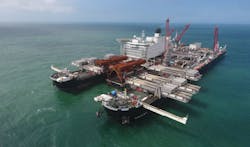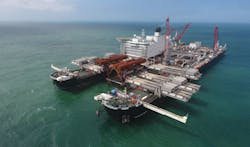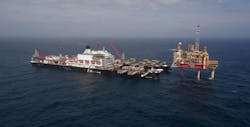Pioneering Spirit proves strength, stability with record topsides lift
Jeremy Beckman
Editor, Europe
Allseas’ multi-purpose vesselPioneering Spirit has come through its first major test, removing the 13,500-metric ton (14,881-ton) topsides from the Yme platform offshore Norway in a single lift during a swift, trouble-free operation. Following further trials with additional lifting beams, the vessel’s next major task will likely be removal next summer of the Brent D platform topsides for Shell in the UK northern North Sea.
After many years of engineering, planning and finally construction, the completed vessel was delivered to Allseas early last year. This July, the company conducted tests at Rotterdam harbor on the 12 lifting beams installed to date on the vessel’s fore-deck. ThePioneering Spirit then performed its first offshore lift on a set of mock topsides that had been placed on a substructure at the K-13 field in the Dutch North Sea. Testing was cut short when a window arose to remove the Yme topsides and with operator Repsol’s permission, this operation was completed on August 22.
The 382-m (1,253-ft) long, 124-m (407-ft) wide DP vessel has a 122-m (400-ft) long, 59-m (193-ft) wide U-shaped slot at its bow which is positioned to fit around three sides of the platform and then lift the entire topsides using up to eight sets of horizontal lifting beams. Allseas cites numerous benefits of a single-lift execution, including a substantial reduction in time spent on preparatory work such as offshore cleaning; partitioning; installing lifting points and modules. There is also less risk to the environment, as a single lift avoids the need for prior purging of process facilities.
In a typical topsides removal sequence, the topsides support legs are cut and final lift preparations undertaken prior to the arrival of the vessel. Once on location, the topsides are lifted via hydraulic clamps or alternatively support yokes, placed on the lifting beams. Each configuration is adjusted to accommodate the dimensions of the structure to be removed: The clamps are carefully closed around the topsides support legs, while support yokes are positioned at pre-determined strong points at the underside of the topsides.
During lifting, although the vessel itself moves due to wave action, all motions of the clamps or yokes relative to the platform are suppressed by engaging the active motion compensation system. Pre-tension in the lift system is increased gradually to transfer the topsides’ weight from the jacket to the vessel. The final stage of the operation involves a rapid lift-off, using hydraulic cylinders with a maximum stroke of 4 m (13 ft), to ensure sufficient clearance and avoid any risk of impact between the topsides and the jacket. Post-removal, the topsides are transferred onto Allseas’ large shallow-water bargeIron Lady, which is purposely designed to fit compactly within the slot at the bow, with the operation taking place either at the onshore decommissioning site or at a suitable nearshore location.
Trial runs
ThePioneering Spirit is also designed for removal of heavy jackets, installation of topsides up to 48,000 metric tons (52,911 tons) and the laying of large-diameter pipes. According to Allseas’ President Edward Heerema, the company developed the concept for the vessel from scratch, with little knowledge of heavy-lift technology in-house aside from his own expertise acquired in his previous role at the Heerema Group. As the project progressed, however, Allseas did bring in experienced specialists to help advance the engineering.
The contracts for Yme and Brent were awarded on a fluid basis, with the timing of the removal jobs to be determined at a mutually convenient date to operator and contractor. For Allseas, the first priority was to demonstrate the vessel’s lifting capabilities in trial runs. Yme’s topsides could have been taken away last year, but operator Repsol had no problem with deferring removal until this summer. “The platform was unmanned, so the costs of maintaining it were minimal to Repsol,” Heerema explained, “and the deferral allowed them to delay the expenditure on the removal program.”
Following installation and commissioning of the initial 12 lifting beams, each was tested individually and in linked pairs at the harbor in Rotterdam this July, with four beams lifting a combined load of 14,700 metric tons (16,204 tons) during the final test. Early in August, the vessel sailed to the K-13 field in the Dutch North Sea for its first practice installation. One month earlier, Seaway Heavy Lifting had installed the test jacket, fixed to the offshore location by suction piles. “Pioneering Spirit could also have installed the jacket,” Hereema said, “but we wanted to get tests on the vessel completed, so we had this done by another company. We fabricated the 5,500-ton [6,063-ton] test topsides ourselves, mostly comprising water-filled tanks in order to achieve the desired weight at the lowest feasible cost.”
Sea conditions for this trial run were relatively benign, he added - up to just over 2 m (6.6 ft) significant wave height - “but we did experience sufficient movement of the ship to demonstrate the active motion heave compensation system. Although we would have liked to do the exercise in rougher seas, it went extremely well, and we were pleased at how accurately we were able to set the topsides down.”
A window of opportunity then arose to perform the first commercial removal job, with the vessel sailing north to the Yme field. The three-legged Yme jackup production platform, commissioned by previous operator Talisman, never entered service due to defects in the base caisson structure which rendered the 3.5-m (11.5-ft) diameter steel tubular legs unstable. “In this case, there was not much pre-survey work to do,” Heerema said, “with the cuts to be made above the water line. We did evaluate how structurally sound the topsides were, and designed lifting yokes to spread the 13,500-metric ton (14,881-ton) load so that the bottom of the topsides stayed in shape.”
The lifting beams were raised to five yoke positions underneath the topsides, one being close to the vessel’s bridge. After the legs had been cut, lifting started in a sea state varying from 2-2.5 m (6.6-8.2 ft) significant wave height. Raising the topsides to a 2-m clearance took around one minute, somewhat longer than the few seconds anticipated, because the vessel’s quick-lift air pressure system had not been fully commissioned at that point. This is a high-pressure air buffer designed to release a huge amount of stored energy at the moment of lift-off. “The reason the system was not ready was because the air valves had not been operating properly and therefore had to be sent back to the factory,” Heerema said. “These have since been repaired and sent back to us.
“The speed of the lift is relevant because of the degree to which the ship moves in the waves. If the crane moves too much, you can’t make a lift. Conventional crane vessels have wires running over many sheaths - in their case, lift-off is therefore never fast and normally takes quite a few minutes.”
During the lifting operation, the combination of the motion compensation system and the DP system kept thePioneeringSpirit stable, with no noticeable reaction. Thereafter the vessel sailed with its cargo to a fjord near the port of Lutelandet, where the deck was transferred to the IronLady and from there to the quayside in a standard skidding exercise. The deck removal established a new world record for a single-lift from an offshore platform, eclipsing the previous record of 12,200 metric tons (13,448 tons) set by Saipem’s S7000.
The vessel has since returned to the quayside at Rotterdam for installation and commissioning of the final set of four lifting beams: all 16 will be needed for the Brent D deck removal, currently scheduled for summer 2017. For this project, the lifting yokes will be different, and this will apply to the vessel’s future lifting assignments. “Each project features different strong points on the bottom of the topsides,” Heerema said, “although we hope in future to re-use some yokes. We fabricate these at our assembly shop in the Netherlands: yokes are basic structural steel elements, essentially large load spreaders.”
In 2018,PioneeringSpirit is due to install the first of three sets of topsides for the four-platform complex at the Johan Sverdrup field in the Norwegian North Sea. This season the vessel will also return to the Dutch test platform for more trials, as operator Statoil has stressed the need for verification of the lifting capability in rough weather.
Witness responses
Representatives from three oil companies observed the test platform lift in the Dutch sector in early August, including one from Repsol, “in order to gain confidence in the vessel’s capabilities,” Hereema said. “During the Yme job, we had one other client in attendance. We got extremely positive and enthusiastic responses to Yme, to the evidence that the ship can do what it is designed to do; that it can undertake a big lift, and do it fast; and that the motion compensation system worked beautifully, even though the lift was performed in relatively good weather.
“There are some companies that did not have the same confidence in the vessel that others have shown and they would not give us a contract before they knew more. We lost out on a contract from a client who might not have drawn the same conclusion if the Yme lift had been done.”
Allseas’ next goal is to complete development of the vessel’s jacket lifting system. “This has been on the drawing board a long time,” Heerema admitted, “but it will not be ready before the end of 2018. In the meantime, we have ordered a large crane with 5,000-metric ton [5,511-ton] capacity that will allow the vessel to lift large jackets in the traditional way. Eventually, it will be able to install and remove jackets weighing up to 20,000 metric tons [22,046 tons]. Most large platform jackets in the North Sea are in relatively good shape, only corroding significantly in the splash zone. Lower down in the sea, steel members typically have adequate strength to withstand lifting operations.”
With decommissioning, as with all other sectors of the industry, offshore operators are pushing for lower costs. However, when the day for removing a platform can no longer be put off, no chances can be taken or corners cut that might impact safety. “The most important limitation of decommissioning cost, as far as we’re concerned, is the amount of strengthening stipulated in the topsides,” Heerema suggested. “If you build too much conservatism into strengthening, it becomes very expensive, a waste that benefits no one. After our first experience with the Yme deck we have been rationalizing our own strengthening requirements - ensuring that the operation is still completely safe, but not unnecessarily conservative.”
Allseas’ next-generation heavy-lift vesselAmazingGrace remains a work in progress. This will be able to perform single-lifts of up to 72,000 metric tons (79,366 tons), 50% more than the PioneeringSpirit. “We are continuing to optimize the design of the new vessel,” Heerema said, “but we have to be 100% sure of its stability. Nevertheless, we expect it to be operational six years from now, or a little over.”


